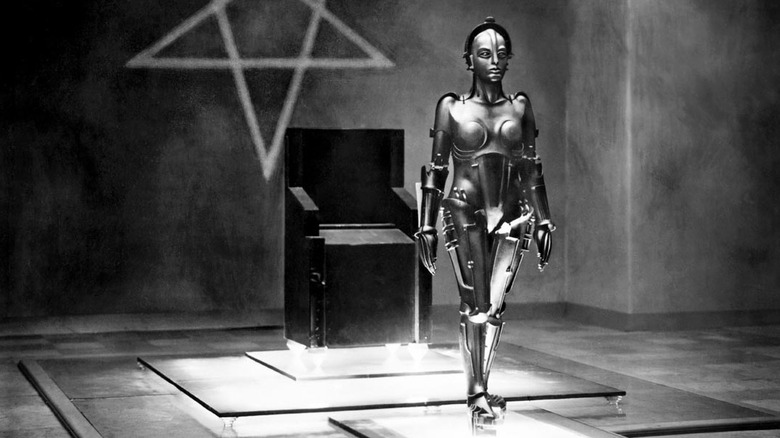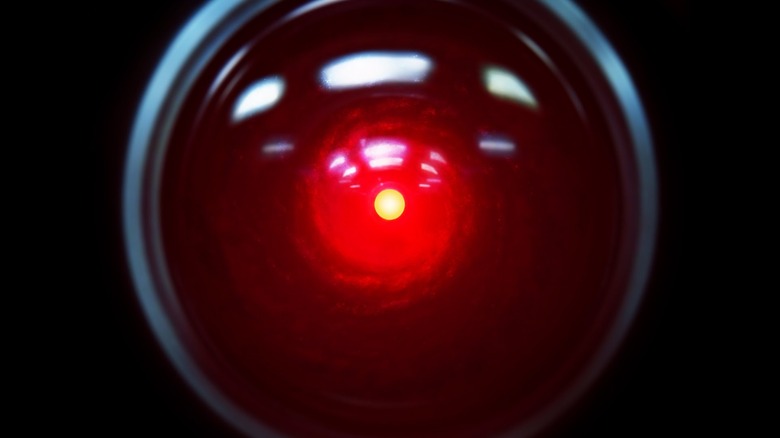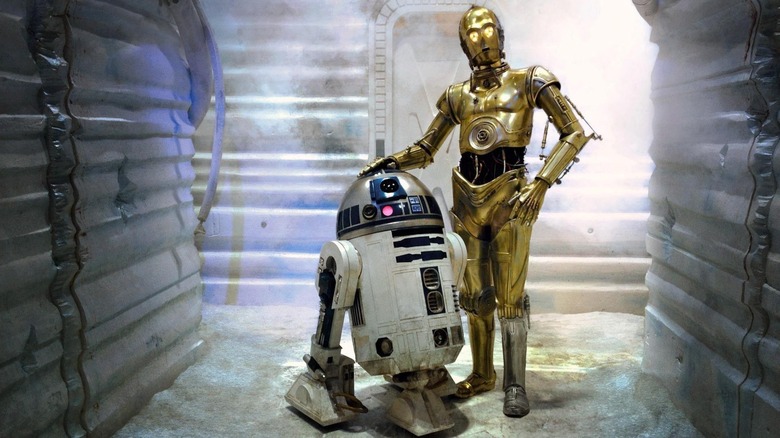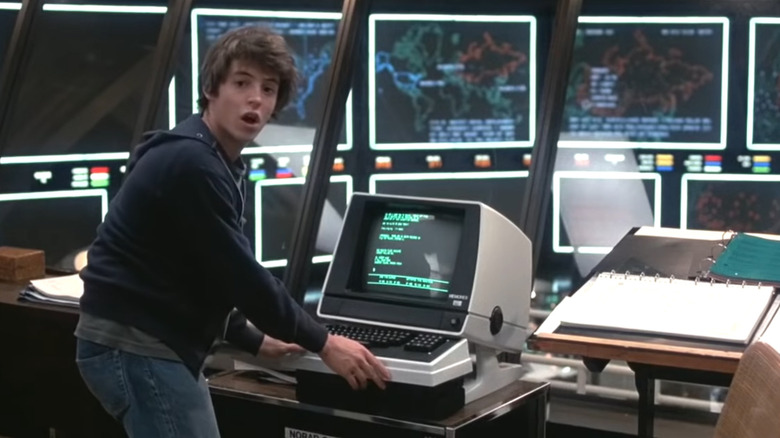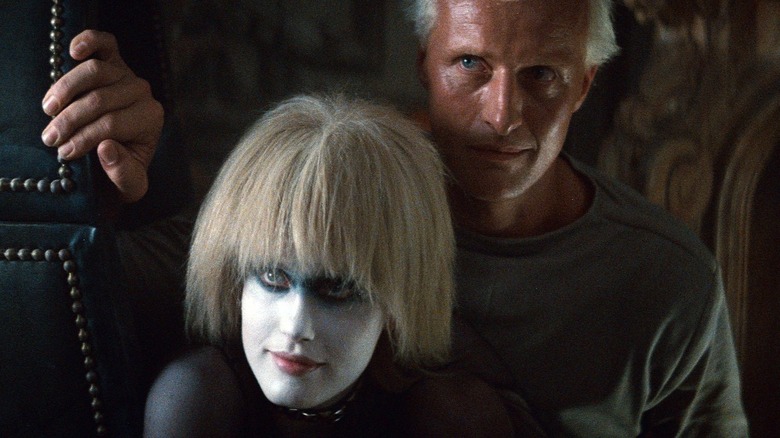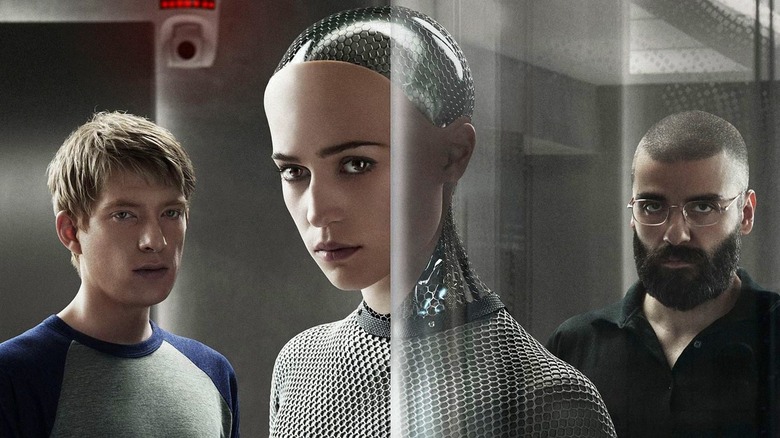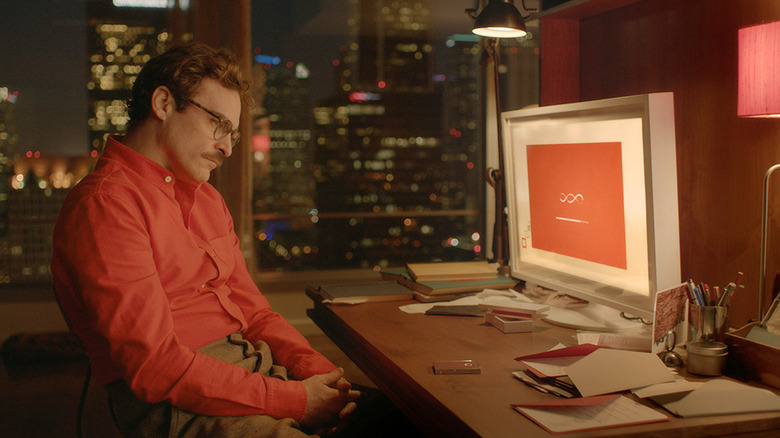The Evolution Of AI In Movies Explained
This content was paid for by Netflix and created by Grunge.
It's probably unwise for anyone to spend an extended amount of time with a piece of shifty artificial intelligence, but Omicron 267 has an especially big problem in "Oxygen." The film features the character waking up in a sealed cryogenic pod with no way out and no memory of how she got there, where she is, or even who she is. Her oxygen supply is running dangerously low, and the only help she can find is MILO — an acronym for medical interface liaison operator — which is an artificial intelligence that's not as forthcoming as it should be.
The new sci-fi thriller comes from acclaimed horror director Alexandre Aja, and while "Oxygen" is full of surprises — not to mention a tour-de-force performance by Mélanie Laurent — the premise of a human interacting with and even relying on AI is something that cinema has been exploring for close to a century now. In fact, MILO is a significant representation of the changing ways that cinema has regarded the digitally sentient because as real-world technology has progressed, so too have the depictions of AI on-screen. Over time, cinematic AIs have evolved from simple, fantastic monsters into nuanced and complex characters that feel just as real — and, at times, even more so — than their human co-stars. Here's a brief look at how the film world's treatment of artificial intelligence has changed over time and how MILO so deftly represents the AI of now.
Cinema's first AI star
The first depiction of an AI character in cinematic history came along in Fritz Lang's "Metropolis," which debuted in 1927. The film was one of the very first sprawling special effect-driven spectacles, centering on workers in a far-future dystopia, where stark class divisions keep workers under the wealthy's thumb, and where reliance on machinery robs laborers of their humanity. It's considered one of the most important science fiction films ever made and imbues its AI with a villainous flair.
In "Metropolis," an inventor decides to use his new robot, known as the Maschinenmensch, to take over the city. In order to do so, he disguises the robot as a young woman named Maria. The artificial Maria sows unrest in the city, convincing citizens to rise up against their masters, commit murder, and destroy the machines used to keep them down. Chaos ensues, and the disillusioned workers ultimately catch the robot and burn her at the stake.
As far as big-screen debuts go, "Metropolis" marked a pretty stark debut for on-screen AI. There's no subtlety here: In "Metropolis," the artificial Maria is straight-up evil. While different cuts of "Metropolis" give the Maschinenmensch different motives — notably, Lang's original version presents the robot as a tool of the rich, while later edits portray it as a rogue agent acting on its own volition — the implication remains the same: AI isn't to be trusted. That sentiment certainly set the tone for many of the AI characters to follow in film history, but Hollywood has also had a few other ideas about how these electric smarties can make a splash on-screen.
At the movies, AI comes into its own
While robots and other AI-powered robots occasionally appeared in movies over the next few decades, the next major AI character didn't show up until 1951, with "The Day the Earth Stood Still." In that movie, an alien visitor named Klaatu shows up on Earth with a silent but powerful robot companion named Gort. However, while Gort is a formidable warrior, he's on a mission of peace. Klaatu and Gort's aim is to convince humans to give up war and join their extra-terrestrial neighbors, who have similarly disavowed violence. The alternative, Klaatu warns, is self-imposed destruction. Unlike the Maschinenmensch, Gort isn't a threat. He's a friend.
Gort made big waves among sci-fi fans, but he was upstaged in 1968, when another AI commanded the screen in Stanley Kubrick's epic "2001: A Space Odyssey." The venerated classic film spans the entirety of human history, but its most famous segment is the one starring HAL 9000, a computer that runs the Jupiter-bound spacecraft Discovery One. Although HAL initially gets along with the two astronauts on board, Dave and Frank, the computer's increasingly erratic behavior begins to worry the two humans. However, when Dave and Frank make plans to shut HAL off, the computer tries to kill them, arguing that his deactivation would put the mission at risk.
While HAL talks in a monotone, he isn't a heartless computer. He's a real, fully fleshed-out character who gets angry when his friends betray him, and who fearfully pleads for his life when his time runs out. He's sinister — HAL's eerily calm "I'm sorry Dave, I'm afraid I can't do that," remains one of cinema's all-time most memorable lines — but he's also oddly relatable. HAL's unique form of villainy was a watershed moment for the depiction of AI in the movies. Afterwards, there was no going back from bringing AI into the movie mainstream.
The AIs of the future, today!
The two different views on AI exemplified by "The Day the Earth Stood Still" and "2001" became even more pronounced in the '70s, when high-concept science fiction became box office gold. On one hand, there was "Star Wars," which presented its two synthetic characters, R2-D2 and C-3PO, as both heroes and comedic foils. These are characters with their own wants and needs and quirky personalities. They may be made out of metal, but functionally, they're just as important as Luke, Han, Leia, and Chewbacca.
On the other, there were movies like Michael Crichton's violent thriller "Westworld," which depicts the carnage that unfolds at a futuristic theme park when the ultra-lifelike animatronics begin to fight back against the tourists who used the mechanical creatures to satiate their basest desires. Like "Star Wars," "Westworld" didn't have a lot of ambiguity about whether its AI characters were good or evil.
AI characters also played a big role in movies like "Alien" and "Star Trek: The Motion Picture" in the same cinematic era, and while the films' treatments of AI as good or evil were drastically different during this time, all of these on-screen AIs had one thing in common: They all lived in the future (or, at the very least, in a galaxy far, far away). Throughout the '70s, AI was still treated like fiction more than science, and it would take a few more years for that to change.
AI comes home
As computers became a bigger part of day-to-day life — and especially once personal computers proved they were here to stay — artificial intelligence became an even hotter topic at the multiplex in the '80s. That decades saw big-budget thrillers and action movies begin to tackle anxiety regarding the real-life possibilities of artificial intelligence head-on. Suddenly, AI wasn't some far-off threat. It was already a part of society, and that made it even more dangerous.
In "WarGames," for example, a teenage hacker accidentally tricks an AI into thinking the Soviet Union is about to launch a nuclear strike, almost starting World War III. In "Tron," the bits and bytes that make up everyday software like accounting programs and video games fight against a corporate AI that has plans for global domination. In "The Terminator," a defense network called Skynet becomes self-aware and launches a war against humanity, using AI-powered soldiers that just happen to look like Arnold Schwarzenegger.
The thread linking all of these movies is pretty clear. These AIs are all inexorably tied to modern-day concerns, particularly the Cold War. Each one is an apocalypse-level threat, and they weren't meant to be that way, either. Typically, it was the algorithms powering them that led to unintended consequences, or the artificial intelligences grow beyond their original parameters, leading to disastrous results. The movies may seem far-fetched, but the implication is that something similar could actually happen, unless we're very careful.
Since then, this take on AI has never really gone away. The machine uprisings in movies like "I, Robot" and "The Avengers: Age of Ultron" may have hit the screen after the USSR collapsed, but they're still spiritual successors to the AI-apocalypse films of the '80s.
Looking at things from the AI's point of view
One big exception, of course, is Ridley Scott's seminal sci-fi film, "Blade Runner." Released in 1982, the film dared to tell the story from the AI's perspective instead of the wary humans afoot. As Harrison Ford's character, Deckard, hunts the escaped AIs known as replicants, we get to know each one of these machines' hopes, fears, and dreams, and quickly realize that they're not all that different from us. "Blade Runner" takes it one step further, though, with one of the best tricks a movie's ever pulled: The film subtly hints that our point-of-view character, Deckard, is a replicant himself, obliterating the line between synthetic and real people.
While characters like HAL 9000 and C-3PO had personalities, "Blade Runner" was unique for its willingness to really explore the full implications of AIs with personalities and present AI characters that were physically and mentally indistinguishable from human beings.
Most importantly, though, "Blade Runner" wasn't about technology. It was about humanity. Scott used artificial intelligence as a way to talk about the very essence of what it means to be human. At the time, that was a bold new way to use AI in a movie, and it had a profound impact on the sci-fi films that followed — once everyone caught up, that is.
The Blade Runner legacy lives on
Here's the thing about "Blade Runner": When it came out, it was a huge flop. Sure, thanks to home video stores and a few director's cuts, the movie eventually gained a cult following and the beloved sequel "Blade Runner 2049," and these days it's considered one of the best science fiction movies ever made. Still, because of the lukewarm start, the influence of "Blade Runner" on sci-fi cinema wasn't immediately apparent.
People caught on eventually, though, and by the time the late '90s and early '00s rolled around, the "Blade Runner" influence was everywhere. Despite its backstory, "The Matrix" is really more concerned with perception than artificial intelligence, but it's hard to imagine we would've gotten Agent Smith, one of the best on-screen villains in movie history, without "Blade Runner" paving the way. The Steven Spielberg-Stanley Kubrick collaboration "A.I. Artificial Intelligence" takes an AI's capacity for love as a foregone conclusion in order to tell a modern-day "Pinocchio" tale. And Alex Garland's "Ex Machina" uses many of the same ideas as "Blade Runner" to examine toxic masculinity's relationship with the concepts of ownership and control.
The trend continued with films like "Battle Angel Alita," "Prometheus," "Big Hero 6," "Ghost in the Shell," HBO's "Westworld" revival, and "Space Sweepers" — the list just goes on and on and on. The idea that AI-powered characters are, somehow, just as human as humans became a solid story starter, thanks in no small part to the "Blade Runner" influence.
We really do love our machines
These days, artificial intelligence is everywhere. It's driving our cars. It's powering our cellphones. It's offering recommendations on what we should buy when we go shopping, or what we should watch next on our favorite streaming services. It's controlling our "smart homes," writing articles, and composing symphonies. Whether you like it or not, the future is already here.
Modern movies have started to adapt to the ubiquity of artificial intelligence. In Spike Jonze's romantic comedy "Her," for example, a man who falls in love with his computer's operating system because AI is just a part of everyday life. The idea that a man might love an AI is presented as relatively mundane, rather than revolutionary, and the movie's real conflict comes from Joaquin Phoenix's inability to communicate with his AI partner, not the premise of the relationship itself. "Her" might be the most complex movie in this genre, but it's far from the only one. The military thriller "Outside the Wire" uses an AI supersoldier as a stand-in for a military drone, and the fact that he has a personality and a sense of purpose is expected, rather than extraordinary. Meanwhile, "Superintelligence" and "Jaxie" are comedies about smart speakers run amok, and The Vision, one of the co-stars of Marvel's "WandaVision," may have begun as Tony Stark's glorified take on Siri but has since developed something akin to a soul, filled with emotions and ambitions and individual thoughts.
MILO in "Oxygen" is part of this latest, modern group of artificial intelligences. No longer is AI some far-away sci-fi marvel, and MILO doesn't have to be a rote hero or a villain. He's also not presented as a manifestation of some deep-seated social anxiety or an elaborate metaphor for the overarching human condition. He's simply a tool of now, albeit one with extra smarts and a smattering of personality, which is an accurate reflection of just how infiltrated and accepted AI has become in present-day storytelling.
There are still plenty of cinematic bots that aim for global domination like the very first one, of course, including Pal in "The Mitchells vs. The Machines," but nowadays the possibilities for on-screen artificial intelligence characters are truly endless.
